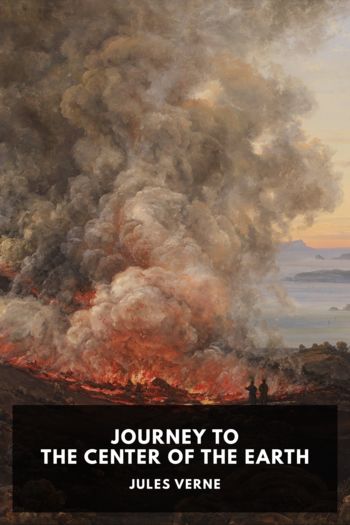Round the Moon by Jules Verne (read aloud txt) 📕

- Author: Jules Verne
Book online «Round the Moon by Jules Verne (read aloud txt) 📕». Author Jules Verne
In the meantime the mountains recognised by Barbicane stood out more and more from the dark mass. They were Mounts Doerfel and Leibnitz, which stand on the southern circumpolar region of the moon.
All the mountains of the visible hemisphere have been measured with perfect exactitude. This perfection will, no doubt, seem astonishing, and yet the hypsometric methods are rigorous. The altitude of the lunar mountains may be no less exactly determined than that of the mountains of the earth.
The method generally employed is that of measuring the shadow thrown by the mountains, whilst taking into account the altitude of the sun at the moment of observation. This method also allows the calculating of the depth of craters and cavities on the moon. Galileo used it, and since Messrs. Boeer and Moedler have employed it with the greatest success.
Another method, called the tangent radii, may also be used for measuring lunar reliefs. It is applied at the moment when the mountains form luminous points on the line of separation between light and darkness which shine on the dark part of the disc. These luminous points are produced by the solar rays above those which determine the limit of the phase. Therefore the measure of the dark interval which the luminous point and the luminous part of the phase leave between them gives exactly the height of the point. But it will be seen that this method can only be applied to the mountains near the line of separation of darkness and light.
A third method consists in measuring the profile of the lunar mountains outlined on the background by means of a micrometer; but it is only applicable to the heights near the border of the orb.
In any case it will be remarked that this measurement of shadows, intervals, or profiles can only be made when the solar rays strike the moon obliquely in relation to the observer. When they strike her directly—in a word, when she is full—all shadow is imperiously banished from her disc, and observation is no longer possible.
Galileo, after recognising the existence of the lunar mountains, was the first to employ the method of calculating their heights by the shadows they throw. He attributed to them, as it has already been shown, an average of 9,000 yards. Hevelius singularly reduced these figures, which Riccioli, on the contrary, doubled. All these measures were exaggerated. Herschel, with his more perfect instruments, approached nearer the hypsometric truth. But it must be finally sought in the accounts of modern observers.
Messrs. Boeer and Moedler, the most perfect selenographers in the whole world, have measured 1,095 lunar mountains. It results from their calculations that ½ of these mountains rise above 5,800 metres, and 22 above 4,800. The highest summit of the moon measures 7,603 metres; it is, therefore, inferior to those of the earth, of which some are 1,000 yards higher. But one remark must be made. If the respective volumes of the two orbs are compared the lunar mountains are relatively higher than the terrestrial. The lunar ones form ¹⁄₇₀ of the diameter of the moon, and the terrestrial only form ¹⁄₁₄₀ of the diameter of the earth. For a terrestrial mountain to attain the relative proportions of a lunar mountain, its perpendicular height ought to be 6½ leagues. Now the highest is not four miles.
Thus, then, to proceed by comparison, the chain of the Himalayas counts three peaks higher than the lunar ones, Mount Everest, Kunchinjuga, and Dwalagiri. Mounts Doerfel and Leibnitz, on the moon, are as high as Jewahir in the same chain. Newton, Casatus, Curtius, Short, Tycho, Clavius, Blancanus, Endymion, the principal summits of Caucasus and the Apennines, are higher than Mont Blanc. The mountains equal to Mont Blanc are Moret, Theophylus, and Catharnia; to Mount Rosa, Piccolomini, Werner, and Harpalus; to Mount Cervin, Macrobus, Eratosthenes, Albateque, and Delambre; to the Peak of Teneriffe, Bacon, Cysatus, Philolaus, and the Alps; to Mount Perdu, in the Pyrenees, Roemer and Boguslawski; to Etna, Hercules, Atlas, and Furnerius.
Such are the points of comparison that allow the appreciation of the altitude of lunar mountains. Now the trajectory followed by the projectile dragged it precisely towards that mountainous region of the southern hemisphere where rise the finest specimens of lunar orography.
XVII TychoAt 6 p.m. the projectile passed the South Pole at less than thirty miles, a distance equal to that already reached at the North Pole. The elliptical curve was, therefore, being rigorously described.
At that moment the travellers re-entered the beneficent sunshine. They saw once more the stars moving slowly from east to west. The radiant orb was saluted with a triple hurrah. With its light came also its heat, which soon pierced the middle walls. The windows resumed their accustomed transparency. Their “layer of ice” melted as if by enchantment. The gas was immediately extinguished by way of economy. The air apparatus alone was to consume its habitual quantity.
“Ah!” said Nicholl, “sunshine is good! How impatiently after their long nights the Selenites must await the reappearance of the orb of day!”
“Yes,” answered Michel Ardan, “imbibing, as it were, the brilliant ether, light and heat, all life is in them.”
At that moment the bottom of the projectile moved slightly from the lunar surface in order to describe a rather long elliptical orbit. From that point, if the earth had been full, Barbicane and his friends could have seen it again. But, drowned in the sun’s irradiation, it remained absolutely invisible. Another spectacle attracted their eyes, presented by the southern region of the moon, brought by the telescopes to within half-a-mile. They left the port-lights no more, and noted all the details of the strange continent.
Mounts Doerfel and Leibnitz formed two separate groups stretching nearly to the South Pole; the former group extends from the Pole to the 84th parallel on the eastern part of the orb; the second, starting from the eastern border, stretches from the 65th degree of latitude to the Pole.
On their





Comments (0)